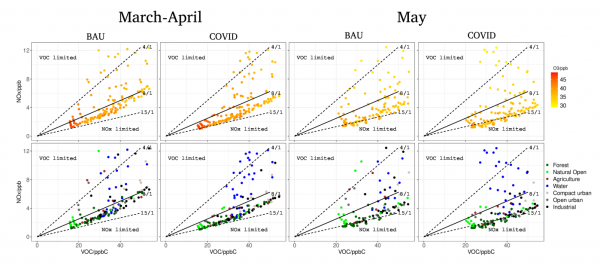New preprint accessible at EGUsphere
13 March 2023
Modelling the impacts of emission changes on O3 sensitivity, atmospheric oxidation capacity and pollution transport over the Catalonia region
ACP manuscript available for public review and discussion on EGUsphere
The preprint is now accessible and open for interactive public discussion until 19 April 2023 here.
Abstract:
Tropospheric ozone (O3) is an important surface pollutant in urban areas, and it has complex formation mechanisms that depend on the atmospheric chemistry and meteorological factors. The severe reductions observed in anthropogenic emissions during the COVID-19 pandemic can further our understanding of the photochemical mechanisms leading to O3 formation and provide guidance for policies aimed at reducing air pollution. In this study, we use the air quality model WRF-Chem coupled with the urban canopy model BEP-BEM to investigate changes in the ozone chemistry over the Metropolitan Area of Barcelona (AMB) and its atmospheric plume moving northwards, which is responsible for the highest number of hourly O3 exceedances in Spain. The trajectories of the air masses from the AMB to the Pyrenees are studied with the Lagrangian particle dispersion model FLEXPART-WRF. The aim is to investigate the response of ozone chemistry to changes in the precursor emissions. The results show that with the reduction in emissions: 1) the ozone chemistry tends to enter the nitrogen oxide (NOx)-limited or transition regimes; however, highly polluted urban areas are still in the Volatile Organic Compounds (VOC)-limited regime, 2) the reduced O3 production is overwhelmed by reduced nitric oxide (NO) titration, resulting in a net increase in the O3 concentration (up to 20 %) in the evening, 3) the increase in the maximum O3 level (up to 6 %) during the lockdown could be attributable to an enhancement in the atmospheric oxidation capacity (AOC), 4) the daily maximum levels of ozone and odd oxygen species (Ox) generally decreased (4 %) in May with the reduced AOC, indicating an improvement in the air quality, and, 5) ozone precursor concentration changes in the AMB contribute to the pollution plume moving along the S–N valley to the Pyrenees. Our results indicate that O3 abatement strategies cannot rely only on NOx emission control but must include a significant reduction in anthropogenic sources of VOCs (e.g., for power plants and heavy industry). In addition, our results show that mitigation strategies intended to reduce O3 should be designed according to the local meteorology, air transport, particular ozone regimes and AOC of the urban area.
Figure: Change in O3 concentrations (top panels) for 30 March to 12 April (only weekdays) and 18 to 30 May (only weekdays) for both simulations, BAU (left panels) and COVID (right panels), over the AMB area during the morning (6-8 UTC). The land use is also displayed for each grid (bottom panels).

